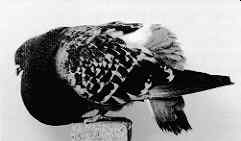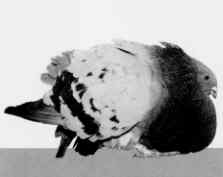 Photo:
G. De La Nuez
Photo:
G. De La Nuez |
Marchenero Pouters |
 Photo:
G. De La Nuez
Photo:
G. De La Nuez
 Photo
Frank Barrachina
Photo
Frank Barrachina
The Marchenero Pouter
For the most part, when a pouter breed is first imported, it takes quite a while for the breed to cathc on. There are exceptins to this rule of thumb, the voorburg Sheild cropper found an instant following among a large group in the 1970ís, and today another captivating little breed, the Marchenero Pouter, has captured the hearts and imaginatins of everyone who sees it for the first time at a show.
What is it about the Marchenero that makes it so endearing? Is it the breedís unusual method of flying, is it the innocent look of a Marchenero, or is it the animated annd friendly demeanor of these "wind up toy" like birds? Itís probably all of thee factors and more!
The History
The Marchenero is one of the oldest pouter breeds, and it is a breed that was developed in Spain in a period of time covering almost on thousand years.
In order to understand the beginnings or ancient history, a brief history lesson is in order. During the MiddleAges, while Europe was divided into hundreds of little feudal principalities, the tribes of the Middle East united under the Islamic religion, and under this unified group of rulers conquered all of the lands in Africa bordering the Mediterranean Ocean. Spain, like the rest of Europe, was divided into numerous feudal kingdoms and was closest to these conquerors, and naturally they invaded that country. They were able to get a foothold in the southern part of Spain that lasted for the better part of 700 years.
These Moors brought their animals with them, and included in that group of animals were pigeons. These were primarily flying pigeons, and there was one in that group that was known for having a tile shaped tail, hence its name, Colitejo. The Calitejo was the ancestor of the Marchenero.
The name Marchenero came along hundreds of years after the Moors were driven out of Spain. How the breed developed and how the crop inflation characteristic came about is unknown. It undoubtedly came about from crossing with other breeds. But then, one needs to examine how pigeons were bred. There werenít any get togethers like shows or even standards. People lived in cities and villages and bred their birds as they liked. Naturally, pigeons with a certain look developed in certain locales, and our little Marchenero was developed in and around Seville.
The Modern Marchenero
Over the centuries, the Marchenero developed the characteristics for which it is known today. Most unusual of these characteristics is the unique method of flaring its tail whether flying or just strutting around the loft.
The tail in the Marchenero resembles that of a lobster and to further emphasize this characteristic the rump feathers hackle up the back. This factor is unique to this breed and its cousin and offshoot the Gaditano.
The Marchenero is a feather pigeon - it has extremely loose feather. On first impression, the Marchenero seems to be a substantially built pigeon, but when you handle one, you suddenly realize that what you thought was a well developed body is no more than a handful of leathers. Loose feathering, certainly does add to the look. Besides the loose feathering on the bank, it also manifests itself with loose feathering around the hocks called canastilla, or basket feathers, and loose feathering over the eyes called tufos.
The Marchenero is a outer and has a well inflated crop. Its crop, however, should not be overly inflated. It is carried in a loose fashion although not pendulous. I feel that crop style is also determined by feather quality. It seems that the bigger the crop, the tighter the feather becomes. When you get tight feather, you hive up on the hackling on the back - which defeats the breedís characteristics.
In Spain, the ideal Marchenero has a crease on its crop that tuns vertically. This is due to the fact that the Marchenero also has as one of its ancestors the Rafeno (pronounced Ra-fen-yo wit a foft "a" and a soft "e") or owl-like porter. Naturally too, the tighter the feather on the crop, the less likely it will have the highly desired crease or "raja" (ra-ha).
To get back to the tail, the feathers often break. This comes about from the constant activity and the fact that the bird often lands on its tail. This is permissible for show, believe it or not, in Spain. But, the feathers must be equally broken on each side of the tail.
The rump feathers are called the double tail because they hackle up and flare out. The rump is wide as well. It is most desirable that this hackling characteristic continue up toh birdís back.
The Marchenero has a relatively small head and a fine medium beak. The wattles and eye ceres are fine as well. The really excellent Marcheneros have the previously mentioned "tufos" or eye brows as we would call them, although tufos translates into locks of hair over the temples.
Keeping in line with these fine characteristics, the legs and feet are also correspondingly fine boned. The legs are medium to short.
Despite the fact that the Marchenero was developed in Spain and is a popular national breed there, another type of Marchenero is being bred in Europe too by Dutch and German fanciers who imported their original birds from Spain in the past few decades. The Marcheneros differ in that they have bigger globes, tighter feather, and donít have the typical crease on the crop. Obviously, the breeding of the other continental pouters has influenced this style. It is a shame though, that important breed characteristics are being lost by some.
Now that the European communities are joining together, there has been a lot of talk and discussion about once again breeding this breed as it was found in its homeland, and hopefully some middle ground will be found for all to unite.
In America
The first few Marcheneros imported to America were birds that found their way here from Canadian lofts that had been importing from Holland. Most of these came here in the early 1970ís and many of these bloodlines have since died out.
Recent importations from Spain by myself and other friends in Southern California have given this breed a new shot in the arm. Importations have also been made by fanciers in the Miami area and again from Spain. It is interesting to note that most of the people importing are either of Spanish decent, like myself, or are Hispanics. Along with this obvious ethnic fervor, comes a desire to breed the Marchenero exactly as it is being bred in Spain. And why not-shouldnít each breed be bred as it was intended to be bred in its homeland? Arenít Voorburgs bred the same around the world? I rest my case!
The Special Personality
One of the things that wins people over to the Marchenero is its tame nature. The Marchenero is a fearless little pigeon, it is always cooing and strutting and always putting on a show.
Because of its very nature, the Marchenero lends itself to being the easiest pouter variety to exhibit. From the time they leave the nest, the Marchenero is naturally tame. It seems as though they can be put in a cage to show train and almost overnight become the wonderful little wind up toys that everybody likes and want. Really, there is nothing to match them!
The charming Marchenero is finding a good home in America, and every year more and more people are taking up their breeding. Donít be surprised to see several hundred of them being displayed some time in the future at a major show, and donít be surprised if they immediately win you over the firs time you see them!
From: Pigeon Fancier, April 93, by Frank Barrachina